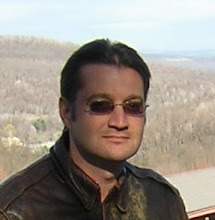In a previous post, I detailed how the Bethesda CBD Master Plan uses Floor Area Ratio (FAR) to set the density level of the area around the Metro station. FAR is gross building area divided by lot area. But Meridian, the applicant for the new 16-story building, persuaded the planning staff to include half the width of several roads around the project, including Wisconsin Avenue and Old Georgetown Road, in the FAR calculation. Why? Because supposedly the roads were once Indian trails associated with the property and Meridian is arguing that they should count towards lot area. Forget the fact that the Indians did not keep deed or plat records.
Furthermore, the project's opponents are alleging that the inclusion of undedicated road area in FAR has occurred several times before, but only when project applicants were represented by Linowes and Blocher. Charles Claxton and Jerry Pasternak, representing Clark Enterprises, wrote to the Planning Board:
It thus appears that this whole theory of the "prescriptive dedication" of Indian trails is not an historic practice, but the recent creation of Linowes and Blocher, the attorneys who initiated this application for Meridian and who first argued that Wisconsin Avenue and Old Georgetown Road should be included in FAR calcuations for Bethesda Metro Center. Recent history has shown that the fact that Linowes and Blocher can convince staff to accept its concepts of zoning compliance is not necessarily a good thing.But Claxton and Pasternak actually go further, baldly stating that the dispute amounts to a repetition of the Clarksburg scandal:
We have seen this scenario before - a developer gets too cozy with staff at the Planning Board and staff enables the developer to violate plans and the law. In Clarksburg I, there was no opportunity for the Board to prevent the integrity of the process from being shattered and citizen confidence in its government undermined. This Board, however, has the opportunity to prevent "Clarksburg II" and should do so by denying the application.The irony of attorneys for Clark, which is a general contractor, developer and construction manager, deploring developer "coziness" with staff is rich. But then what does Rollin Stanley, the new Planning Director, do but add new ammo to the opponents' arguments. According to the Post:
Stanley criticized the opponents during a speech Friday to members of the Bethesda-Chevy Chase Chamber of Commerce. He suggested that they are too focused on minutiae and don't see the big picture, which he said is a growing need for more housing and jobs near public transit as gas prices skyrocket.The role of the Planning staff, including its Director, is not to criticize a development applicant or any other parties expressing views on an application. The staff's role is to offer its best professional guidance to the Planning Board. Stanley, who over-ruled lower-ranking staff who originally recommended against the new office building, is treading dangerously close to the line on this project.
"Planning shouldn't be about sitting in a room with five lawyers talking about the road in 1781. When you get to that level... something has gone wrong."
Stay tuned folks - this dispute is just getting started.


No comments:
Post a Comment